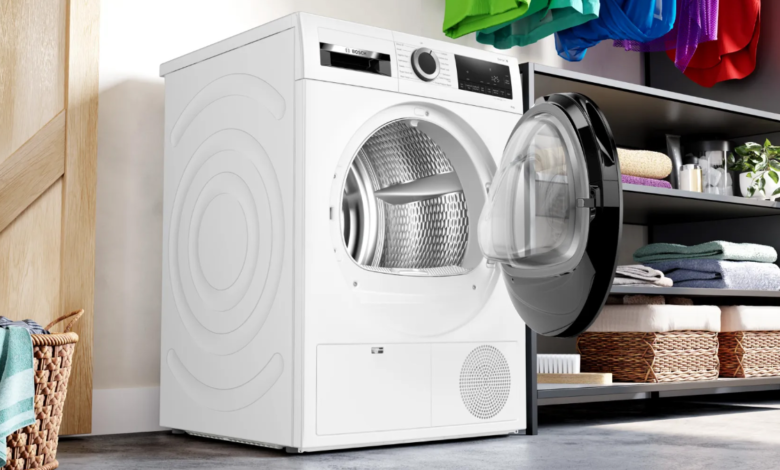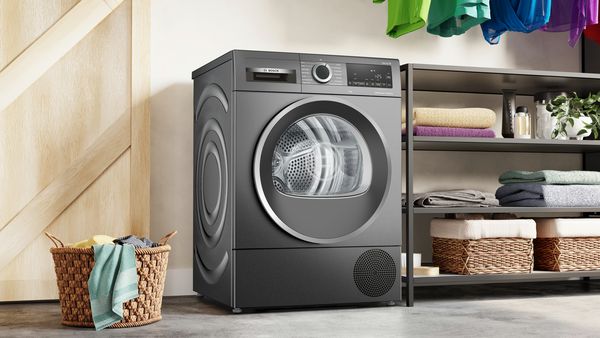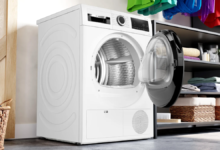Condenser Tumble Dryer: The Complete Expert Guide

Discover everything about condenser tumble dryers with our expert guide. Learn how they work, benefits, drawbacks, comparisons, FAQs, and buying tips in one detailed, easy-to-read article.
Introduction to the Condenser Tumble Dryer
A condenser tumble dryer has become one of the most popular home appliances for modern households. Unlike traditional vented dryers, it offers flexibility in placement and brings convenience for families who don’t want the hassle of external venting. When you hear the term condenser tumble dryer, you might immediately think of compact technology designed for convenience. That’s not wrong at all—it’s one of the biggest reasons these dryers are trending in today’s homes.
The rise of the condenser tumble dryer is not just about fashion or modern looks. It’s about functionality and lifestyle fit. Busy families, young professionals, and anyone living in apartments or homes without an outside wall find it particularly appealing. With no need for a vent hose, it simplifies drying clothes while keeping efficiency high.
How a Condenser Tumble Dryer Works
At its core, the condenser tumble dryer uses a heating element to warm up air inside the drum. Clothes tumble through the hot air, releasing moisture. Instead of pushing that moisture outdoors through a vent, the machine pulls it into a condenser unit. Inside, the vapor condenses into water, which collects in a tank or is drained away.
The genius of this process lies in its independence from external conditions. You don’t have to place your machine near a window or wall vent. You can put a condenser tumble dryer in a kitchen corner, a hallway, or even a spare room. The self-contained system is what makes it so attractive.
Why People Prefer a Condenser Tumble Dryer
Convenience is often the first reason people switch to a condenser tumble dryer. The lack of external venting makes installation simple. You can slide it into any space with a power supply. For apartment dwellers, this alone is a game-changer.
Another reason is consistency. A condenser tumble dryer does its job regardless of weather. Whether it’s rainy, cold, or humid outside, you can count on dry clothes. You don’t have to rely on a clothesline or even a vent pipe leading outdoors. This makes it a year-round solution for busy households.
Key Features That Make a Condenser Tumble Dryer Stand Out
One of the best things about a condenser tumble dryer is the water collection tank. It is simple to empty and usually slides out with ease. Some models even allow you to connect a small hose directly to a drain, removing the need to empty manually.
Modern machines also come with sensors. These sensors detect the moisture level in your laundry and stop the cycle when clothes are perfectly dry. That not only prevents overdrying but also saves energy. In addition, many condenser tumble dryers have different settings, such as “cupboard dry,” “iron dry,” and “extra dry,” giving you flexibility depending on how you want to finish your laundry.
Comparing Condenser Tumble Dryer to Other Dryers
When choosing between dryers, it’s important to know how a condenser tumble dryer stacks up against alternatives. Vented dryers, for example, push damp air outside through a hose. While effective, they require placement near a wall or window, limiting where you can put them.
Heat pump dryers are another option. These are even more energy-efficient than condenser tumble dryers, but they often cost more upfront. They use a closed-loop system with refrigerant, recycling heat rather than letting it escape. The trade-off is that drying cycles can take longer. In comparison, a condenser tumble dryer sits nicely in the middle—affordable, flexible, and efficient for most homes.
Benefits of Using a Condenser Tumble Dryer
The biggest benefit is placement freedom. You don’t need an external wall or a venting system, making it ideal for apartments and homes without laundry-specific layouts. Flexibility is unmatched.
Another benefit is drying performance. A condenser tumble dryer usually dries faster than a heat pump dryer and handles large loads with ease. Its programs are straightforward, and modern models often feature energy-saving technologies, such as moisture sensors or eco settings, reducing unnecessary electricity use.
Drawbacks You Should Consider
Every appliance has downsides, and a condenser tumble dryer is no exception. One key drawback is energy use. While more efficient than older vented machines, it usually consumes more electricity than a heat pump dryer.
Maintenance is another factor. The condenser unit and lint filter require regular cleaning to keep performance smooth. Forgetting to empty the water tank or clean filters may affect drying times and overall efficiency. While it’s not difficult, it’s something users need to keep on their checklist.
Best Places to Put a Condenser Tumble Dryer
Because of its flexible installation, you can place a condenser tumble dryer almost anywhere. Popular locations include kitchens, utility rooms, or even hallways. As long as there’s good airflow and a power socket, you’re good to go.
That being said, it’s best to avoid confined areas without ventilation. While a condenser tumble dryer doesn’t push damp air outside, it still generates warmth. A small, closed space could become uncomfortably warm over time.
Energy Efficiency and Cost of Running
Energy ratings are a big deal when buying appliances. A condenser tumble dryer often comes with a rating ranging from B to A++. The higher the rating, the less energy it uses. Keep in mind that while initial costs may be lower than heat pump dryers, running costs can add up over years of use.
If you do a lot of laundry, you might notice this difference on your energy bill. However, for occasional users, the balance between cost and convenience makes a condenser tumble dryer very attractive. It’s important to calculate your expected usage when deciding.
Maintenance Tips for Your Condenser Tumble Dryer
Taking care of your machine ensures a longer lifespan. The first task is emptying the water tank after each cycle unless you’ve connected a drain hose. Skipping this can cause the machine to stop mid-cycle.
Cleaning the lint filter is equally important. Lint buildup affects airflow and efficiency. Every few weeks, also rinse out the condenser unit under running water to clear any trapped lint or debris. A little routine care goes a long way in keeping your condenser tumble dryer in excellent shape.
Buying Guide: What to Look for in a Condenser Tumble Dryer

When shopping, size matters. Think about drum capacity. Larger households will benefit from a bigger drum, while singles or couples may prefer a compact design.
Features also make a difference. Look for sensor drying, multiple program options, and energy efficiency ratings. Noise level is another factor—especially if you’re placing it in a shared space like a kitchen. Always compare warranties too, as a longer warranty often signals confidence in the product’s durability.
Common Myths About the Condenser Tumble Dryer
One myth is that condenser tumble dryers ruin clothes faster. In reality, modern machines use gentle drum action and moisture sensors to avoid overdrying, protecting fabrics better than old vented dryers.
Another myth is that condenser tumble dryers are too expensive to run. While they can cost more than air-drying clothes, for many households the convenience and year-round performance outweigh the slightly higher energy bills.
Quick Comparison Table
Here’s a quick look at how a condenser tumble dryer compares with alternatives:
| Feature | Condenser Tumble Dryer | Vented Dryer | Heat Pump Dryer |
|---|---|---|---|
| Installation | Flexible, no vent required | Needs wall or window vent | Flexible, no vent required |
| Energy Use | Moderate | Higher | Lower |
| Price | Mid-range | Low | High |
| Drying Speed | Fast | Fast | Slower |
| Maintenance | Tank + filter cleaning | Filter + vent hose | Filter + condenser cleaning |
Expert Opinion on Condenser Tumble Dryer
“As a laundry appliance, the condenser tumble dryer strikes a perfect balance between performance and practicality. It gives you freedom of placement without forcing you into long drying cycles, and modern features like sensor drying make it smarter than ever before.”
This perspective highlights why the condenser tumble dryer has become a mainstream favorite. It offers that sweet spot between old-school vented dryers and the newer, pricier heat pump models.
FAQs About Condenser Tumble Dryer
Q: Do condenser tumble dryers need a vent?
A: No, that’s their main advantage. Moisture is collected in a tank or drained away instead of vented outside.
Q: Are condenser tumble dryers expensive to run?
A: They use more energy than heat pump dryers but are cheaper to buy. For many households, the balance works out well.
Q: Can I put a condenser tumble dryer in a cupboard?
A: It’s not recommended. These dryers generate heat, so they need adequate airflow around them to work safely and efficiently.
Q: How often should I clean the condenser unit?
A: Usually every month, but it depends on usage. Regular cleaning keeps drying times consistent.
Q: Is a condenser tumble dryer safe for all fabrics?
A: Yes, when using the correct settings. Most modern models come with programs for delicate fabrics, sportswear, and mixed loads.
Conclusion
A condenser tumble dryer is a reliable, flexible, and user-friendly solution for modern households. It removes the limitations of venting, offers quick and effective drying, and suits a wide range of living spaces. While not the most energy-efficient option available, its balance of cost, convenience, and performance makes it one of the most popular laundry appliances today.
If you’re looking for a practical dryer that combines freedom of placement with solid performance, a condenser tumble dryer is an excellent choice.





